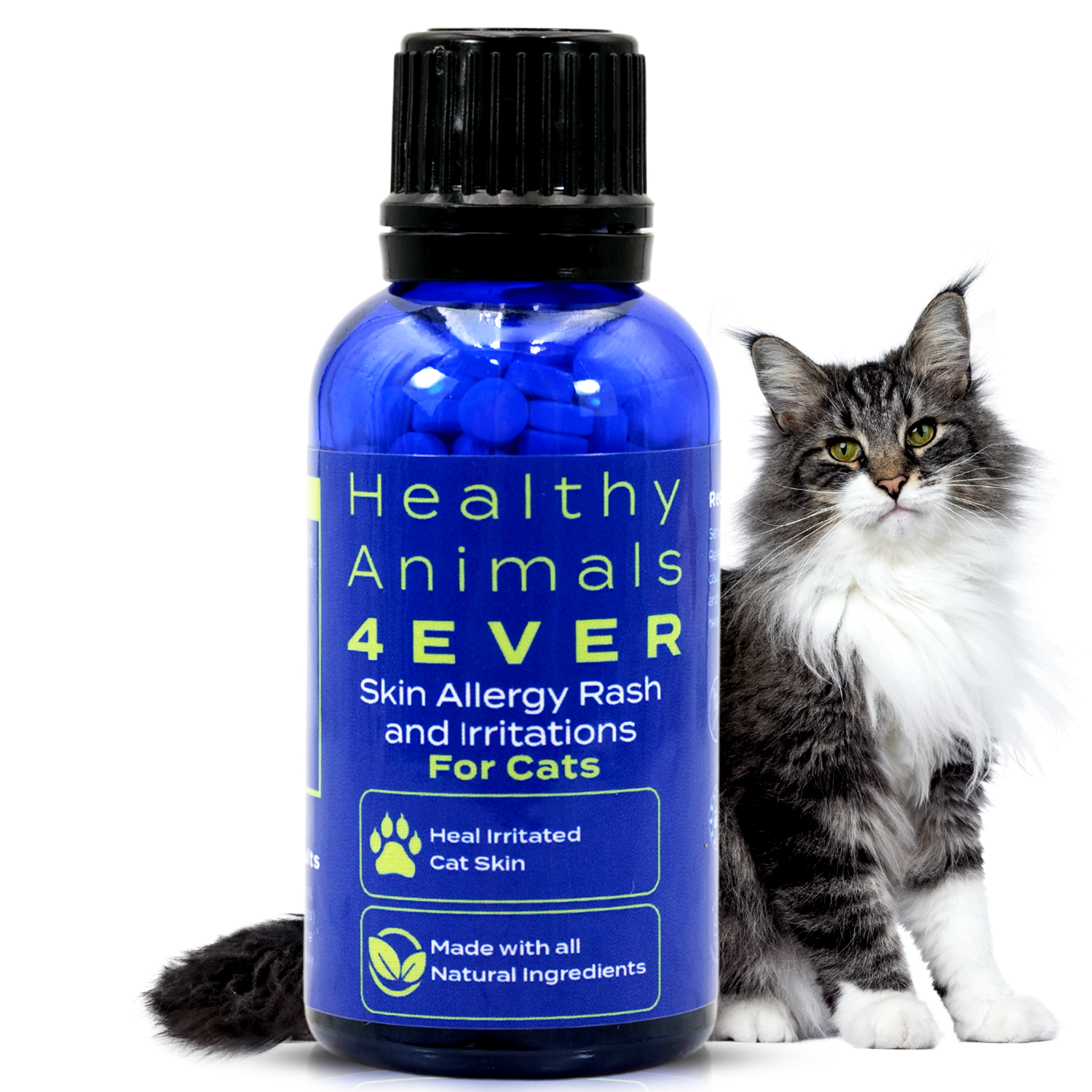DEALING WITH CAT ALLERGIES
You may have a cat allergy if you have an itchy nose, sneezing, red eyes or itchy skin when in contact with cats. Stay with me and find out in the following few lines if you are allergic to cat hair.
Cats are present in our lives and our homes. Unfortunately, some people may have a cat allergy, which can become a big problem and significantly affect the quality of our lives. Especially when the cat is considered a family member and donating the pet is out of the question.
If you sneeze, your nose is itchy and stuffy, your eyes water, itch and turn red when you come in contact with a cat; you probably have a cat allergy. Your skin may also become red and itchy. In more severe cases, you may experience other symptoms like coughing, shortness of breath and chest pain leading to a bronchospasm (asthma) crisis.

Up to 30% of people with asthma may have an asthma attack when in contact with cat fur.
These symptoms can occur even if the cat is no longer in the environment! Cat allergens are microscopic and can be suspended in the air for a long time.
Cats cause allergies in humans through 8 allergenic proteins (allergens) secreted mainly by their sebaceous glands.
The allergen responsible for 96% of cat allergy cases is called Fel d 1. It is found mainly in the cat's skin and fur.
The intensity of cat allergy symptoms will depend on the individual predisposition and the intensity of exposure to the cat. It may occur within minutes of contact with the cat or when entering a house with a cat.
When an allergic person's immune system comes into contact with the cat allergen, it triggers a reaction that can lead to the following symptoms:
Cat Allergy Symptoms
Rhinitis symptoms
- itchy nose
- Nasal obstruction
- sneezing
- Runny nose (clear discharge from the nose)
- Itchy throat, the roof of mouth and ears
Symptoms of conjunctivitis
- itchy eyes
- redness in the eyes
- tearing
- Swollen eyes
Symptoms of hives and dermatitis
- Red patches on the skin and bumps
- itchy skin
Symptoms of bronchospasm and asthma
- Shortness of breath
- Cough
- wheezing
- Chest pain/pressure
Why do some people develop cat allergies and others do not?
Allergic people generally have a strong genetic component that increases the chance of developing allergies to different things throughout their lives. If one of your parents is allergic, has asthma, rhinitis, atopic dermatitis or allergic conjunctivitis, you have a 50% chance of developing allergies. If both parents have allergies, this chance increases to 70%.
And you can develop an allergy to many things. The most common allergy is house dust mites. Second, comes cat and dog allergies.
According to The American College of Allergy, Asthma & Immunology, unfortunately, no hypoallergenic (non-allergic) cat breeds exist. All cats produce the allergen Fel d 1, and the other allergens responsible for cat fur allergy attacks. If there is more than one cat in the house, the greater the number of allergens in the environment, leading to more flare-ups. Characteristics such as breed, fur size and sex of the animal did not influence the number of allergens in the environment, according to studies.
Although there is no genuinely hypoallergenic cat breed, some breeds produce less Fel d 1 protein and, theoretically, could be better tolerated by those allergic to cats. Here are some examples:
- Siberian cat
- Balinese cat
- devon rex
- cornish rex
- Abyssinian cat
Cat allergens, from Fel d 1 to Fel d 8, are tiny particles suspended in the air for hours. Long after the cat leaves the room, allergens can be present in the air and cause a cat dander allergy.
Furthermore, dust mite allergy is extremely common (more common than cat allergy). Mites feed on epithelial debris, i.e., dandruff, fur, and skin. So, in a house with a cat, the number of mites will be much higher, and consequently, the person will have more allergic crises.
Cat allergies are twice as common as dog allergies.
Can cat allergies kill?
Some people are so allergic to cats that they can trigger a severe asthma attack and even death. However, this is extremely rare. Severe cases like this usually happen in those with severe and uncontrolled asthma. The cat, in this case, would be the trigger for the asthma attack.

How do I know if I have a cat allergy?
Symptoms such as itchy nose, eyes and throat, nasal obstruction, and red itchy skin when in contact with the cat help diagnose. Certainty, however, comes with allergic tests, prick tests (immediately read skin tests) or specific IgE blood tests.
The prick test is a quick and painless test performed on the spot by the allergist, confirming the diagnosis of cat allergy. The result comes out in 15 minutes and is highly accurate.
A few drops of various allergens, such as dust mites, fungi, and dog and cat hair, are placed on the patient's forearm. After some time, a mild allergic reaction occurs at the droplet site to which the patient is allergic.
The blood test is an alternative and can be easily performed in any laboratory. Cat-specific IgE is requested; the result will appear in a few days.
You might also like the following:
How to get rid of cat allergy naturally?
Avoiding contact is the best way to minimize cat allergy symptoms. If you don't have cats at home, don't adopt one and avoid environments with cats. If you have a cat at home but donating the pet is impossible, this will significantly help:
- Let the cat out of your room. Preferably restrict access to just a few rooms. This does not prevent particles suspended in the air from migrating to your room and causing cat allergy, but it minimizes the intensity of crises.
- Do not come into direct contact with the cat by stroking and kissing. If you do, wash your hands, eyes and nose after contact.
- Sterilizers and air filters can help decrease the total number of allergens in the air.
- Use a vacuum cleaner and mop the house regularly.
- Bathe the cat at least once a week.
- Hypoallergenic cat food can help reduce the dander from the cat.
Other Treatment Options
Anti-allergy: These are fast-acting medications and mainly relieve the symptoms of itching, sneezing, and red plaques on the body. They do not help so much in the treatment of nasal obstruction. Preferably, you could try the most modern 2nd and 3rd generation antiallergics that do not cause drowsiness—for example, desloratadine, fexofenadine, levocetirizine and bilastine.
You can use the antiallergic after the cat allergy crisis. If you know you will come into contact, you can take the antiallergic even before.
If you visit a person with a cat, start taking anti-allergy medication a few days beforehand.
Nasal corticosteroids are the best remedy for nasal symptoms, especially nasal obstruction. This is a great treatment option if you have a cat at home and are constantly allergic to cat dander.

Oral corticosteroids: Used only for more severe attacks of cat allergy, as they have more acute adverse effects. It should be used for at most 7-10 days, and frequent use should be avoided.
Nasal wash with saline solution – Essential in treating rhinitis without any adverse effects. Studies show a 30% improvement in cat allergy rhinitis symptoms with frequent nasal wash.
Anti-leukotrienes – Used to prevent the symptoms of rhinitis, asthma and conjunctivitis triggered by various allergens, including Fel d 1, which causes cat allergy.
Asthma medications – Inhaled corticosteroids and bronchodilators are medications used for asthma attacks. They should be used if there is pulmonary involvement.
-
Immunotherapy (vaccine treatment)
Immunotherapy is the only treatment available that can potentially treat cat allergies.
It consists of applying small amounts of cat allergen to the patient to desensitise them and stop having an allergy to cat hair.
The treatment is long and lasts between 2-3 years. It is usually done with subcutaneous injections at the beginning of 7/7 days. Over time, the applications are spaced until reaching 1x/month. Most of the treatment is one monthly dose.
This vaccine treatment stimulates the patient's immune system to become accustomed to the cat antigens and ceases to have a cat allergy.
This treatment can be combined with other antigens if necessary. So, if the patient is also allergic to dogs or house dust (mites), a single dose of the vaccine can be used to treat all these problems.
It has excellent results for the symptoms of rhinitis, conjunctivitis, and asthma.
Conclusion
Cat allergies can be a complex problem to manage. Still, dealing with cat allergies without giving away the cat is possible. Avoiding contact with cats, using air purifiers, cleaning regularly, and using allergen-proof bedding and allergen-reducing shampoos can help reduce cat allergy symptoms. Additionally, modifying the diet may also help alleviate the symptoms of cat allergies. Managing cat allergies without giving away your beloved pet is possible with a little effort.









